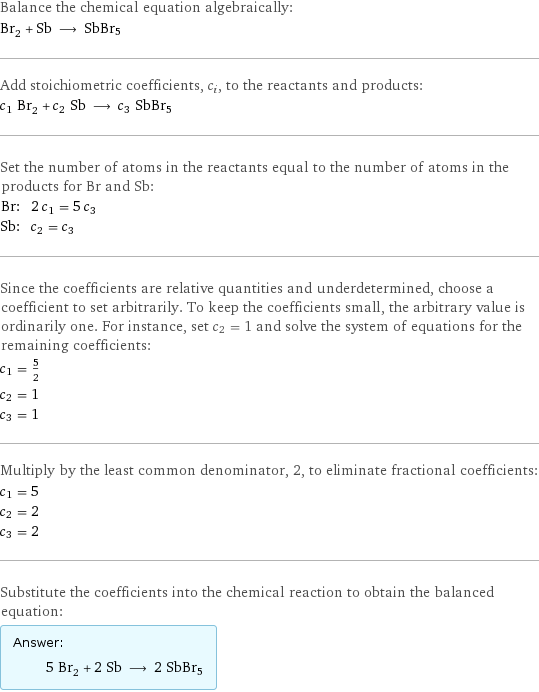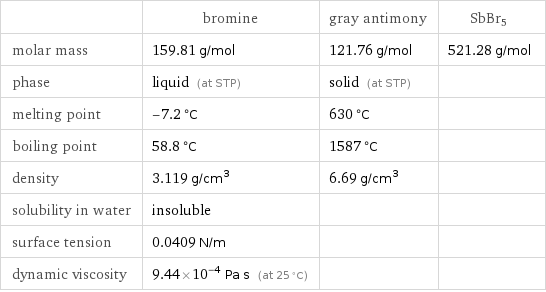Input interpretation

Br_2 bromine + Sb gray antimony ⟶ SbBr5
Balanced equation

Balance the chemical equation algebraically: Br_2 + Sb ⟶ SbBr5 Add stoichiometric coefficients, c_i, to the reactants and products: c_1 Br_2 + c_2 Sb ⟶ c_3 SbBr5 Set the number of atoms in the reactants equal to the number of atoms in the products for Br and Sb: Br: | 2 c_1 = 5 c_3 Sb: | c_2 = c_3 Since the coefficients are relative quantities and underdetermined, choose a coefficient to set arbitrarily. To keep the coefficients small, the arbitrary value is ordinarily one. For instance, set c_2 = 1 and solve the system of equations for the remaining coefficients: c_1 = 5/2 c_2 = 1 c_3 = 1 Multiply by the least common denominator, 2, to eliminate fractional coefficients: c_1 = 5 c_2 = 2 c_3 = 2 Substitute the coefficients into the chemical reaction to obtain the balanced equation: Answer: | | 5 Br_2 + 2 Sb ⟶ 2 SbBr5
Structures

+ ⟶ SbBr5
Names

bromine + gray antimony ⟶ SbBr5
Equilibrium constant
![Construct the equilibrium constant, K, expression for: Br_2 + Sb ⟶ SbBr5 Plan: • Balance the chemical equation. • Determine the stoichiometric numbers. • Assemble the activity expression for each chemical species. • Use the activity expressions to build the equilibrium constant expression. Write the balanced chemical equation: 5 Br_2 + 2 Sb ⟶ 2 SbBr5 Assign stoichiometric numbers, ν_i, using the stoichiometric coefficients, c_i, from the balanced chemical equation in the following manner: ν_i = -c_i for reactants and ν_i = c_i for products: chemical species | c_i | ν_i Br_2 | 5 | -5 Sb | 2 | -2 SbBr5 | 2 | 2 Assemble the activity expressions accounting for the state of matter and ν_i: chemical species | c_i | ν_i | activity expression Br_2 | 5 | -5 | ([Br2])^(-5) Sb | 2 | -2 | ([Sb])^(-2) SbBr5 | 2 | 2 | ([SbBr5])^2 The equilibrium constant symbol in the concentration basis is: K_c Mulitply the activity expressions to arrive at the K_c expression: Answer: | | K_c = ([Br2])^(-5) ([Sb])^(-2) ([SbBr5])^2 = ([SbBr5])^2/(([Br2])^5 ([Sb])^2)](../image_source/ed22daa6acba1795123614009be9cb19.png)
Construct the equilibrium constant, K, expression for: Br_2 + Sb ⟶ SbBr5 Plan: • Balance the chemical equation. • Determine the stoichiometric numbers. • Assemble the activity expression for each chemical species. • Use the activity expressions to build the equilibrium constant expression. Write the balanced chemical equation: 5 Br_2 + 2 Sb ⟶ 2 SbBr5 Assign stoichiometric numbers, ν_i, using the stoichiometric coefficients, c_i, from the balanced chemical equation in the following manner: ν_i = -c_i for reactants and ν_i = c_i for products: chemical species | c_i | ν_i Br_2 | 5 | -5 Sb | 2 | -2 SbBr5 | 2 | 2 Assemble the activity expressions accounting for the state of matter and ν_i: chemical species | c_i | ν_i | activity expression Br_2 | 5 | -5 | ([Br2])^(-5) Sb | 2 | -2 | ([Sb])^(-2) SbBr5 | 2 | 2 | ([SbBr5])^2 The equilibrium constant symbol in the concentration basis is: K_c Mulitply the activity expressions to arrive at the K_c expression: Answer: | | K_c = ([Br2])^(-5) ([Sb])^(-2) ([SbBr5])^2 = ([SbBr5])^2/(([Br2])^5 ([Sb])^2)
Rate of reaction
![Construct the rate of reaction expression for: Br_2 + Sb ⟶ SbBr5 Plan: • Balance the chemical equation. • Determine the stoichiometric numbers. • Assemble the rate term for each chemical species. • Write the rate of reaction expression. Write the balanced chemical equation: 5 Br_2 + 2 Sb ⟶ 2 SbBr5 Assign stoichiometric numbers, ν_i, using the stoichiometric coefficients, c_i, from the balanced chemical equation in the following manner: ν_i = -c_i for reactants and ν_i = c_i for products: chemical species | c_i | ν_i Br_2 | 5 | -5 Sb | 2 | -2 SbBr5 | 2 | 2 The rate term for each chemical species, B_i, is 1/ν_i(Δ[B_i])/(Δt) where [B_i] is the amount concentration and t is time: chemical species | c_i | ν_i | rate term Br_2 | 5 | -5 | -1/5 (Δ[Br2])/(Δt) Sb | 2 | -2 | -1/2 (Δ[Sb])/(Δt) SbBr5 | 2 | 2 | 1/2 (Δ[SbBr5])/(Δt) (for infinitesimal rate of change, replace Δ with d) Set the rate terms equal to each other to arrive at the rate expression: Answer: | | rate = -1/5 (Δ[Br2])/(Δt) = -1/2 (Δ[Sb])/(Δt) = 1/2 (Δ[SbBr5])/(Δt) (assuming constant volume and no accumulation of intermediates or side products)](../image_source/8a6622584458f4ad1f62ea4f2fe7292f.png)
Construct the rate of reaction expression for: Br_2 + Sb ⟶ SbBr5 Plan: • Balance the chemical equation. • Determine the stoichiometric numbers. • Assemble the rate term for each chemical species. • Write the rate of reaction expression. Write the balanced chemical equation: 5 Br_2 + 2 Sb ⟶ 2 SbBr5 Assign stoichiometric numbers, ν_i, using the stoichiometric coefficients, c_i, from the balanced chemical equation in the following manner: ν_i = -c_i for reactants and ν_i = c_i for products: chemical species | c_i | ν_i Br_2 | 5 | -5 Sb | 2 | -2 SbBr5 | 2 | 2 The rate term for each chemical species, B_i, is 1/ν_i(Δ[B_i])/(Δt) where [B_i] is the amount concentration and t is time: chemical species | c_i | ν_i | rate term Br_2 | 5 | -5 | -1/5 (Δ[Br2])/(Δt) Sb | 2 | -2 | -1/2 (Δ[Sb])/(Δt) SbBr5 | 2 | 2 | 1/2 (Δ[SbBr5])/(Δt) (for infinitesimal rate of change, replace Δ with d) Set the rate terms equal to each other to arrive at the rate expression: Answer: | | rate = -1/5 (Δ[Br2])/(Δt) = -1/2 (Δ[Sb])/(Δt) = 1/2 (Δ[SbBr5])/(Δt) (assuming constant volume and no accumulation of intermediates or side products)
Chemical names and formulas

| bromine | gray antimony | SbBr5 formula | Br_2 | Sb | SbBr5 Hill formula | Br_2 | Sb | Br5Sb name | bromine | gray antimony | IUPAC name | molecular bromine | antimony |
Substance properties

| bromine | gray antimony | SbBr5 molar mass | 159.81 g/mol | 121.76 g/mol | 521.28 g/mol phase | liquid (at STP) | solid (at STP) | melting point | -7.2 °C | 630 °C | boiling point | 58.8 °C | 1587 °C | density | 3.119 g/cm^3 | 6.69 g/cm^3 | solubility in water | insoluble | | surface tension | 0.0409 N/m | | dynamic viscosity | 9.44×10^-4 Pa s (at 25 °C) | |
Units
